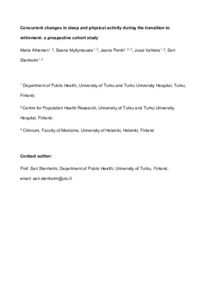Concurrent changes in sleep and physical activity during the transition to retirement: a prospective cohort study
Pentti J; Alhainen M; Stenholm S; Vahtera J; Myllyntausta S
https://urn.fi/URN:NBN:fi-fe2021042827133
Tiivistelmä
Background
Currently, little is known regarding whether changes in physical activity are associated with changes in sleep in general population. The aim of this study was to examine the association between changes in physical activity and changes in sleep duration and difficulties at retirement transition point.
Methods
Data from the prospective Finnish Retirement and Aging study of 2745 retired public sector employees was used. Participants answered questionnaires before and after the retirement with one year interval, in which they reported average weekly hours of physical activity, sleep duration and the frequency of sleep difficulties. The level of physical activity, classified as ‘low’, ‘moderate’ or ‘high’, before and after retirement was used to classify the participants to five physical activity groups. Changes in sleep duration (in minutes) and sleep difficulties (no, moderate, severe) were examined in these physical activity groups.
Results
Before retirement, high physical activity was associated with longest sleep duration (7 h 8 min) and low physical activity was associated with severe sleep difficulties (OR 1.23, 95% CI 1.06–1.44) in comparison to high physical activity. During retirement transition, sleep duration increased in all physical activity change groups and sleep difficulties decreased significantly in ‘stable’, ‘increase from moderate’, ‘decrease from moderate’ and ‘decrease from high’ groups. Changes in sleep duration and sleep difficulties were not statistically significantly different between the physical activity change groups.
Conclusion
Sleep duration increases and sleep difficulties decrease after retirement. Changes in sleep during retirement transition seem to be independent of changes in physical activity during the same time period.
Kokoelmat
- Rinnakkaistallenteet [19204]
